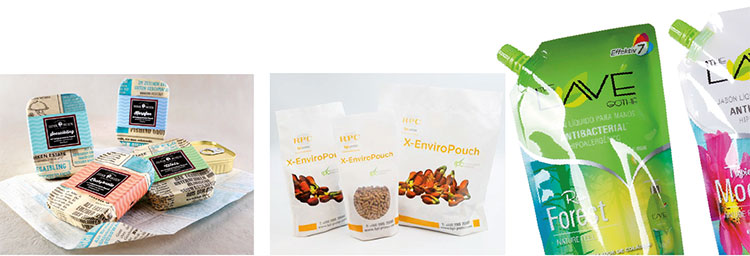Flexible packaging – Data 2017
A recent analysis shows that about one pack out of two in Europe is represented by flexible packaging. Data and facts of a mature but very vital sector. Barbara Iascone

The area of flexible converter packaging is characterized by positive growth trends, thanks above all to its versatility, which makes it suitable for packaging a variety of different products and making it very competitive compared to other materials.
The sector, in Italy, has always enjoyed excellent health even in times of economic crisis, managing to remain stable in terms of production.
Another reasons for pride of this industry, are the stability of employment levels: the number of people employed has indeed always grown even in the darkest moments of the Italian economy.
Having filed away the positive results for 2017, the sector has reached a stage of maturity, and this is why the pace of growth is lower than in the past.
A significant component of the sector is represented by exports which, in 2017, accounted for about 47% of production: there were positive trends not only with regard to the export of empty packaging but also to the export of full packaging. In many destination sectors in which Italy is a good exporter, flexible converter packaging has an excellent share (this is the case of coffee, cheese, pasta and bakery products, petfood and for fresh cut convenience fruit and vegetables).
A look at the world market ...
According to an analysis by PCI Films Consulting for 2016, the value of the global flexible converter packaging market was around 86 billion dollars (+2.5% compared to the previous year): of these, 27% is attributable to North America, 24% to Central and Eastern Asia, 17% to Western Europe, 17% to South East Asia and Oceania. The remaining 15% is divided between the rest of the world.
Again according to the same analysis, the European market grew by 2%, reaching a value of 13.8 billion euros: Germany appears to be the largest European producer of flexible packaging, while Italy, Spain and the UK alternate in second place.
... and Italian market trends
The number of companies active in Italy has remained unchanged for many years. These are 78 companies, whose production grew by 2.3% in 2017 compared to the previous year, reaching 381,500 tons. Domestic demand has driven growth, closing at +4.3%. Also in 2017, exports were stable, which has not been the case for some time, albeit confirmed as a fundamental component of production. The performance derives from the high quality of the product offered and from the guaranteed service to the customer. In 2017 the sector turnover reached 2,132 million euros (+1.9% compared to 2016). Imports are constant and still in limited quantities. Analysing the market from 2010 to today, production has been supported by an average annual growth rate of 3.6%, while turnover is almost 4%, but. As for the subdivision of the type of laminated materials, according to the analysis of the Istituto Italiano Imballaggio, 73% of the flexible converter polylaminates consists of plastic-coated polylaminates, 25% are paper-based and 2% feature an aluminium prevalence.

Raw materials
The progressive lightening of the flexible converter packaging continues, also highlighted by the examination of the mix of raw materials used in the production of laminates. In terms of tons, in 2017 the raw materials are generally stable; going into further detail, increases in the use of paper and cardboard (+0.5%) and aluminium (+0.5%) are seen. The use of different types of plastic are seen to be stable.
Areas of use: Food and non-food areas
Also referred to 2017, the food area remains the main market for flexible polylaminate converter packaging, accounting for a share of 92.9%. The constant growth of ready-to-eat foods influences this segmentation, first and foremost fresh cut convenience produce, but also ready meals and frozen products. It is precisely the ready-to-use food sector that is giving great vigor to this type of packaging, in Italy but, aboveall, at an international level. In European countries such as Germany, for example, consumption of this type of product is growing at a sizeable rate and in recent years the phenomenon has also affected Italy.
Among the sectors of use of the food area, the first goes to bakery and pasta products (20.8%), followed by fresh cut convenience fruit and vegetable produce (21.6%), which also show better performances in terms of consumption, and by cheeses (18.9%).
Still with reference to other food sectors that use flexible packaging, we find: processed and cured as well as cold cut meats (7% in progressive growth both deriving from the industry and products packed in the GDO); frozen foods (6.3%), coffee (3.6%), petfood (4.3%, showing steady growth, flexible packaging is eroding market shares of other packaging, especially tins and and aluminium trays: Convenient to transport, ready to use and, above all, available in single-dose packs, they are suitable to contain dry and wet products).
Lastly, under the heading “other foods” (11.9%), one has sauces, ready meals, fish products, sweets and confectionery in general, baby food, yoghurt, spices, olives for consumption, honey, tomato derivatives, fresh meat, drinks, condiments, spices, etc.
In the beverage sector the use of this material to create the cheerpacks is growing, a type of packaging that could undermine the use of single-dose bricks (in 2017, the percentage of the use of cheerpacks in the juice packaging mix fruit was around 1.2% and growing).
In the “non-food” sector, the domestic detergent sector shows a 3.7% share, while the pharmaceutical and cosmetics-perfumery sectors are at 3.8%.
In both areas, the phenomenon already registered last year is confirmed, according to which refills, both for home cleaning products and for personal care products, are increasingly gaining ground: cheaper and lighter, packaging made of flexible materials is growing at the expense of plastic bottles.
Another phenomenon that affects the two areas is the massive presence of single-dose packs, usually sachets made of flexible material: the free samples in perfumeries or the monodoses used in the pharmaceutical sector for cream or granule products.
Barbara Iascone
Istituto Italiano Imballaggio

















